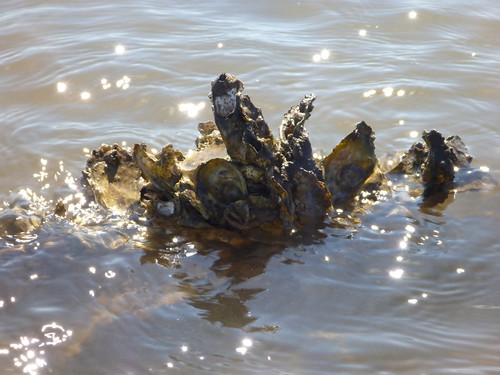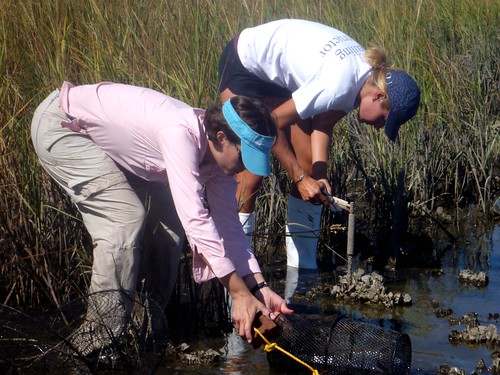Dr. Randall Hughes FSU Coastal & Marine Lab
 When I worked as a technician for our current collaborator Jon Grabowski back when he was in graduate school, one of his favorite sayings as we headed out to the field was “This is where the magic happens”. Yesterday and today I got to experience that magic again as I made my first visit to our oyster sites in Cedar Key. Though I spend a lot more time with plants these days, I do love oyster reefs. Maybe it’s because the first field research I did was on reefs (with Jon), or maybe it’s because of the mystique they seem to hold for nearly everyone, but it sure was fun to hear those shells crunch as I stepped out of the boat.
When I worked as a technician for our current collaborator Jon Grabowski back when he was in graduate school, one of his favorite sayings as we headed out to the field was “This is where the magic happens”. Yesterday and today I got to experience that magic again as I made my first visit to our oyster sites in Cedar Key. Though I spend a lot more time with plants these days, I do love oyster reefs. Maybe it’s because the first field research I did was on reefs (with Jon), or maybe it’s because of the mystique they seem to hold for nearly everyone, but it sure was fun to hear those shells crunch as I stepped out of the boat.
Of course, in addition to “the magic”, there’s also the cuts and scrapes, the no see-ums, and frustrating way that nets get caught on every oyster clump within 2 ft. But something about the reefs wins me over every time!
Enough of all the nostalgia – what did we actually accomplish? Hanna and I started about midday on Sunday, deploying traps at each of the sites. We realized as we headed back to the boat ramp that the return trip we were scheduled to make later that evening after deploying nets would have been pretty challenging in the dark, so we spent most of the afternoon seeking out a plan B. Thanks to some wonderful people in Cedar Key, we ended up docking the boat for the night at a home just near our sites! Around 6pm we headed out to pick up the traps. We didn’t find a whole lot – a few speckled seatrout and some killifish – but we were able to deploy our nets without any trouble (other than the previously mentioned no see-ums). By 9:30pm we were back at the rental house eating our frozen pizza dinner.
 This morning we got up and headed back out to see what was in our nets. Somewhat surprisingly, it was all mullet and catfish! Not that we didn’t expect those fish to be there, but we thought we’d get a greater variety of species. There were also 2 red drum, 1 blue crab, and a couple of crown conchs, but mostly it was mullet, mullet, mullet.
This morning we got up and headed back out to see what was in our nets. Somewhat surprisingly, it was all mullet and catfish! Not that we didn’t expect those fish to be there, but we thought we’d get a greater variety of species. There were also 2 red drum, 1 blue crab, and a couple of crown conchs, but mostly it was mullet, mullet, mullet.
After we got turned around heading back to the boat ramp, I was really glad that we hadn’t tried that trip in the dark last night! All in all, it was a trouble-free trip to the field, and a welcome opportunity for me to see some of “the magic” again myself.


1 comment
[…] Randall writes about her return to the reef. Snails climbing on cordgrass reproductive stems in the field. […]
Comments are closed.